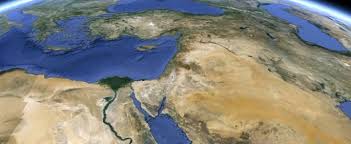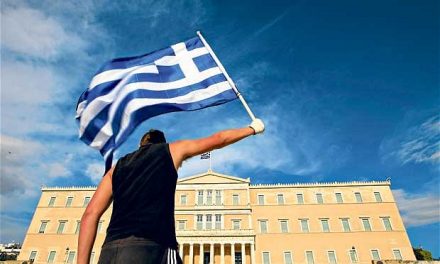By NAZLAN ERTAN, Hurriyet Daily News
In the 15th Istanbul Biennial, the theme grabs you almost as much as the works of art. It is a misleadingly simple, event upbeat phrase: “A Good Neighbor.”
Yet, it is so emotionally explosive, so laden with baggage and so variable that, as the Nordic duo of curators, Elmsgreen and Dragset said, it seems to have an invisible question mark at the end. The inevitable reply, after touring the six different venues of the Biennial, that a good neighbor, in the troubled Middle East and the troubled world, is hard to find, let alone to be.
Is a good neighbor simply someone who does not storm into your village, destroy your house and kill your parents? Yes, if we go by one of the most forceful works of the Biennial, the short video of Mardin-born Turkish artist Erkan Özgen, where a deaf-mute boy describes without words the violence he has witnessed when the Islamic State of Iraq and the Levant (ISIL) fighters seized Kobani in January 2015. In this video ironically titled “Wonderland,” the thirteen-year-old Mohammed’s account ends with a brutal hand movement that shows a decapitation. According to many critics, the video is “the crown piece” of the Biennial, which is otherwise subtle in its political criticism.
Is a good neighbor someone who does not spy on you? Turkish artist Burçak Bingöl’s surveillance cameras, made of white porcelain and decorated with flowers, takes up the global surveillance culture. In Turkey, it strongly recalls the culture of snitching, the recent headlines about a man who complained about his neighbor to the police for wearing shorts in Ankara and the calls by the president and the government to report to the police if you think your neighbor was involved in a conspiracy against the government.
Is a good neighbor one who will let you live your life the way you choose, even if it means letting you cry alone? That is the question posed by Egyptian artist Mahmoud Khaled’s installation, called “Proposal for a Memorial for a Crying Man,” which tells the story of a semi-fictional, faceless character who dwells in a two-story house in Istanbul’s Bobo Cihangir neighborhood. The story of the Crying Man, a major image for the LGBTI community in the Middle East, starts in 2001, when several men were arrested on a gay disco boat in Cairo. Arrested, tortured and taken before a court for “sodomy,” the men appeared in the Egyptian media as they entered the courthouse with their faces covered with a white cloth—almost like a shroud that symbolized their social death in the Egyptian society. Khaled’s fictive character, based on one of the 52 men, settles in Istanbul, where he strives to create a meticulous house and a new life. The somber voice of the audio-guide lulls you into accepting the fictive “Crying Man” as a real figure of intrigue for his neighbors—one they have respected but kept at a distance, even when they knew, from the crying sounds, that he was unhappy.
Is a good neighbor someone who has just moved next door, with his unknown past and memories? Iraq-born Mahmoud Obaidi escaped Iraq with a fake passport in 1991 when the American invasion was underway and led the life of a nomad, hoping he would one day go back home, until he realized in 2003 that it just would not happen. His “Compact Home Project,” is a series of eight books with metal covers containing some of his sketches, newspaper clippings and letters. “These are what I have carried with me as home,” he said. “I entombed the fragmented remnants of my nomadic life inside [those] artists’ books.
These objects then only existed inside this artwork, as traces of impossible return, shadows of an infeasible life and parodies of a non-existent home.” So much like the small things taken by the Syrian refugees today.
Is a good neighbor one who will go on the streets with you, or help you up when you have been stupefied with tear gas and encourage you to go on? The chipped murals made by Moroccan artist Latifa Echakhch in the Istanbul Modern show people demonstrating the 2013 Gezi Park protests and how the spirit of resistance eventually faded away. The work is called “Crowd Fade.” Echakch also has done similar work on another movement that faded away, the Takrir Square demonstrations.
One of the works that have captured the zeitgeist and the neighborhood theme is Gazi Sansoy’s “3rd Vienna Siege and refugees” in Anna Laudel Gallery’s “Past Meets Present”—one of the neighbor activities of the Biennial. It couples the classical scenes of 16th century western paintings with the pop-culture figures of today: Angela Merkel and Vladimir Putin are in religious poses, with piles of euros in front of them, as women, half naked, covered or in any attire in between look on the scene. A faceless Ottoman sultan rides toward the center, behind him, refugees kept behind fences, while a series of men who resemble Pieter Brueghel’s “Blind Leading the Blind” walk behind. The sultan’s face, in a pop-art purple, is turned toward a distant city, with a dominant mosque and carelessly made collective-houses, including one built on the sea.
The sultan’s wife, stands near, most of her face covered with a veil and her eyes small with laughter, while his son, wearing a thief’s mask and a reddish mustache, is placed right near the pile of euros. Ask the curators what these people signify, and they reply, “These are imaginative figures.”
Perhaps a good neighbor, like a good artist, is one who stimulates your imagination.



















